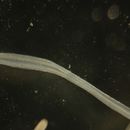pms
nòm ant ël fil


“13. THELEPUS ANTARCTICUS.
(Pl. XLV., fig. 6.)
Thelepus antarcticus, Kinberg, J. G. H., 1866 ‘Annulata Nova,’ Oft,. Ak. Forh., p. 345.
It is noteworthy that not one of the three collections of Antarctic Polychaeta recently examined by Prof. Ehlers3 contained this highly characteristic species. Not only is it a true Thelepus, s. str., but it is probably co-specific with the northern type, Thelepus cincinnatus (Fabr.).
One fragment, comprising the head and thirty setigerous segments, upwards of 2 inches long, was dredged off Cape Adare in 8 fathoms, January 17, 1900.
The fore-part of the body or thoracic region comprises approximately the first twenty-five setigerous segments, which differ from the abdominal segments in their greater girth, but not in respect of the parapodial armature.
A mid-thoracic segment measures 7 mm. crosswise by 2 mm. lengthwise ; an abdominal segment, 3 ½ mm. x 4 mm. ; so that an average abdominal segment is equal to half the width and twice the length of a typical thoracic segment.
The entire dorsal surface is characterised by a rich glandular pustulose structure which still preserves a slimy surface. The translucent hypodermal pustules are of varying sizes, irregular in their distribution, larger and more abundant than in the specimens of. Thelepus cincinnatus which I have examined.
The tori uncinigeri commence on the third setigerous segment, and thereafter the tori and capillary fascicles co-exist to the end of the specimen (and of the body, Kinberg), there being no mutation of segments in regard to the distribution of setae, except that the tori become more pro-eminent in the abdominal segments, while the dorsal capillary fascicles suffer a slight reduction.
The simple filiform branchiae are more numerous on the second than on the third segment, the latter being the first setigerous segment.
The specimen offered certain chaetographical abnormalities. In the nineteenth setigerous segment there was no torus on the left side ; the twenty-fourth and twenty-fifth pharetrae (notopodium and neuropodium) of the right side had no antimeres on the left side ; finally, the twenty-fifth right capillary fascicle was not subtended by the usual torus.
The uncini are uniserial throughout and exactly resemble those of Thelepus cincinnatus figured by von Marenzeller,1 being characterised by the presence of two rows of accessory uncinules at the vertex and by a rounded process (mucro) at the distal end of the basal portion.
3 Ehlers, E., 1897. ‘Polychaeten.’ Ergebnisse Hamburg. Magelhaensischen Sammelreises, 11th Lief.
Ehlers, E., 1900. ‘Magellanishe Anneliden der schwedischen Expedition.’ Nachr. Ges. Göttingen, Heft 2, p.206.
Ehlers, E. 1901. ‘Die Anneliden der Sammlung Plate.’ ‘Fauna Chilensis,’ Pd. II., Heft 2, p.251 (Suppt. V., Zool. Jahrb.).
1Marenzeller, F. von, 1884. ‘Zur Kenntniss der adriatischen Anneliden,’ III. S.-B. Akad. Wien, Bd. 89, p.206.”
(Willey, 1902)
Thelepus setosus is een borstelworm uit de familie Terebellidae. Het lichaam van de worm bestaat uit een kop, een cilindrisch, gesegmenteerd lichaam en een staartstukje. De kop bestaat uit een prostomium (gedeelte voor de mondopening) en een peristomium (gedeelte rond de mond) en draagt gepaarde aanhangsels (palpen, antennen en cirri).
Thelepus setosus werd in 1866 voor het eerst wetenschappelijk beschreven door Quatrefages.
Bronnen, noten en/of referenties